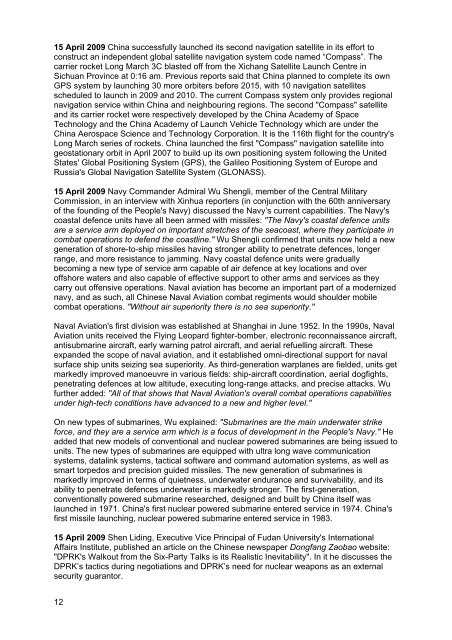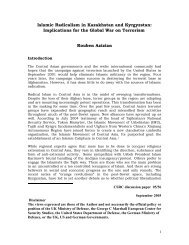South China Sea. The vessel left the Zhuhai port and headed for Sanya, a port in thesouthern-most island province of Hainan. The vessel will join the largest-ever joint marineinspection in mid <strong>April</strong> launched by the maritime authorities in Guangdong, Hainan andShanghai. The ship, along with Guangdong's "Haibiao-32" and Shanghai's "Haixun-21", arethe main forces in the joint operation. The patrol aims to monitor the sea environment, checkthe main sea routes, route markings and other facilities on the sea and ensure shipping orderand safety.15 <strong>April</strong> <strong>2009</strong> Premier Wen Jiabao told visiting New Zealand Prime Minister John Key thatChina and New Zealand should work together to deal with the international financial crisis."This would benefit both countries and the region as well." Key hailed the New Zealand-China FTA, which was signed in <strong>April</strong> 2008. Despite the global downturn, trade between thetwo countries grew by 19 per cent to more than 9 billion New Zealand dollars in a yearending February <strong>2009</strong>. "The China-New Zealand FTA is a good model for others in ourregion as it points the way to openness at a time when protectionist pressures are building."Key claimed that New Zealand would invest more in China and planned to develop businessoffices in cities like south China's Shenzhen and eastern Qingdao.15 <strong>April</strong> <strong>2009</strong> Beijing - Kazakhstan's President Nursultan Nazarbayev arrived on a five-daystate visit to China at the invitation of <strong>Chinese</strong> President Hu Jintao, which will include talkswith Hu, Wu Bangguo and Premier Wen Jiabao respectively in Beijing and Sanya, a port inthe southern-most island province of Hainan.15 <strong>April</strong> <strong>2009</strong> Beijing - Vice-President Xi Jinping told visiting Mongolian Prime Minister SanjBayar that China would work with Mongolia to advance the relationship between the twocountries.Mongolia and Tianjin, a municipality in northern China, signed a memorandum on deepeningeconomic cooperation, pledging to strengthen economic ties and expand the fields ofcooperation. Zhang Gaoli, member of the Political Bureau of the <strong>Chinese</strong> Communist PartyCentral Committee and party chief of Tianjin, when meeting the visiting Mongolian PrimeMinister, said that Tianjin and Mongolia had maintained cooperative relations and it waswilling to deepen cooperation in more fields.15 <strong>April</strong> <strong>2009</strong> Beijing - Ministry of Commerce spokesman Yao Jian warned the US to deal"cautiously" with the anti-dumping complaint from US steel makers that China dumpedspecific types of tubular and pipe steel into the US market. Yao said that in the first quarter,the volume of <strong>Chinese</strong> steel exports to the US fell 55 per cent from a year ago. China washighly concerned about the suit and would send a delegation to the US to discuss the matter.Beijing - The <strong>Foreign</strong> Ministry stated that Richard Holbrooke, US envoy for Afghanistan andPakistan, will visit China 15-16 <strong>April</strong> <strong>2009</strong>. Niu Xinchun, vice-director of the Centre forAmerican Studies at the China Institute of Contemporary International Relations, said thevisit was another sign of US President Barack Obama's new strategy on Afghanistan andPakistan. "The US is actively seeking cooperation with the countries neighbouring the twoterrorism-plagued areas, with China its biggest targeted partner."15 <strong>April</strong> <strong>2009</strong> Beijing - Egyptian Ambassador to China Mahmoud Allam asserted that Egyptwould increase its trade with China and co-operation over nuclear power. "Egypt hopes tofurther work together with China in the fields of nuclear energy, renewable energy and powerplants." According to the ambassador, the bilateral trade volume reached 6.2 billion USdollars in 2008 and China is expected to be the biggest trade partner of Egypt in 2010.15 <strong>April</strong> <strong>2009</strong> Beijing - Ministry of Commerce announced that foreign direct investment inChina posted a 20.6 per cent year-on-year decline in the first quarter to 21.78 billion USdollars.11
15 <strong>April</strong> <strong>2009</strong> China successfully launched its second navigation satellite in its effort toconstruct an independent global satellite navigation system code named “Compass”. Thecarrier rocket Long March 3C blasted off from the Xichang Satellite Launch Centre inSichuan Province at 0:16 am. Previous reports said that China planned to complete its ownGPS system by launching 30 more orbiters before 2015, with 10 navigation satellitesscheduled to launch in <strong>2009</strong> and 2010. The current Compass system only provides regionalnavigation service within China and neighbouring regions. The second "Compass" satelliteand its carrier rocket were respectively developed by the China Academy of SpaceTechnology and the China Academy of Launch Vehicle Technology which are under theChina Aerospace Science and Technology Corporation. It is the 116th flight for the country'sLong March series of rockets. China launched the first "Compass" navigation satellite intogeostationary orbit in <strong>April</strong> 2007 to build up its own positioning system following the UnitedStates' Global Positioning System (GPS), the Galileo Positioning System of Europe andRussia's Global Navigation Satellite System (GLONASS).15 <strong>April</strong> <strong>2009</strong> Navy Commander Admiral Wu Shengli, member of the Central MilitaryCommission, in an interview with Xinhua reporters (in conjunction with the 60th anniversaryof the founding of the People's Navy) discussed the Navy’s current capabilities. The Navy'scoastal defence units have all been armed with missiles: "The Navy's coastal defence unitsare a service arm deployed on important stretches of the seacoast, where they participate incombat operations to defend the coastline." Wu Shengli confirmed that units now held a newgeneration of shore-to-ship missiles having stronger ability to penetrate defences, longerrange, and more resistance to jamming. Navy coastal defence units were graduallybecoming a new type of service arm capable of air defence at key locations and overoffshore waters and also capable of effective support to other arms and services as theycarry out offensive operations. Naval aviation has become an important part of a modernizednavy, and as such, all <strong>Chinese</strong> Naval Aviation combat regiments would shoulder mobilecombat operations. "Without air superiority there is no sea superiority."Naval Aviation's first division was established at Shanghai in <strong>June</strong> 1952. In the 1990s, NavalAviation units received the Flying Leopard fighter-bomber, electronic reconnaissance aircraft,antisubmarine aircraft, early warning patrol aircraft, and aerial refuelling aircraft. Theseexpanded the scope of naval aviation, and it established omni-directional support for navalsurface ship units seizing sea superiority. As third-generation warplanes are fielded, units getmarkedly improved manoeuvre in various fields: ship-aircraft coordination, aerial dogfights,penetrating defences at low altitude, executing long-range attacks, and precise attacks. Wufurther added: "All of that shows that Naval Aviation's overall combat operations capabilitiesunder high-tech conditions have advanced to a new and higher level."On new types of submarines, Wu explained: "Submarines are the main underwater strikeforce, and they are a service arm which is a focus of development in the People's Navy." Headded that new models of conventional and nuclear powered submarines are being issued tounits. The new types of submarines are equipped with ultra long wave communicationsystems, datalink systems, tactical software and command automation systems, as well assmart torpedos and precision guided missiles. The new generation of submarines ismarkedly improved in terms of quietness, underwater endurance and survivability, and itsability to penetrate defences underwater is markedly stronger. The first-generation,conventionally powered submarine researched, designed and built by China itself waslaunched in 1971. China's first nuclear powered submarine entered service in 1974. China'sfirst missile launching, nuclear powered submarine entered service in 1983.15 <strong>April</strong> <strong>2009</strong> Shen Liding, Executive Vice Principal of Fudan University's InternationalAffairs Institute, published an article on the <strong>Chinese</strong> newspaper Dongfang Zaobao website:"DPRK's Walkout from the Six-Party Talks is its Realistic Inevitability". In it he discusses theDPRK’s tactics during negotiations and DPRK’s need for nuclear weapons as an externalsecurity guarantor.12
- Page 1 and 2: Research & Assessment BranchSpecial
- Page 3 and 4: promote the harmonious and steady g
- Page 5 and 6: confirmed China’s readiness to wo
- Page 7 and 8: investment protectionism:"During ti
- Page 9 and 10: 10 April 2009 Rayong, Thailand - Ch
- Page 11: 13 April 2009 Beijing - Wang Shengj
- Page 15 and 16: Nursultan Nazarbayev and about 30 r
- Page 17 and 18: trade.” He announced a 10 billion
- Page 19 and 20: 20 April 2009 Beijing - Chief of th
- Page 21 and 22: 21 April 2009 Gansu - A 105-member
- Page 23 and 24: Uganda's relations with China as wo
- Page 25 and 26: Russia:The Russian cruiser CG-011 V
- Page 27 and 28: Lastly, Chen points out that the na
- Page 29 and 30: Paraguay, headed by the party’s p
- Page 31 and 32: assuming responsibilities."Zhang Sh
- Page 33 and 34: said:"There will still be caps on e
- Page 35 and 36: pressures continue."The Chinese gov
- Page 37 and 38: sides. The three agreements are: "T
- Page 39 and 40: Chen also exchanged views with US T
- Page 41 and 42: the resumption of ARATS-SEF talks l
- Page 43 and 44: Andreas Foerster, Chief Operating O
- Page 45 and 46: 28 April 2009 London - A one-day fo
- Page 47 and 48: determined actions to protect core
- Page 49 and 50: Security Council did not apologize
- Page 51 and 52: Faridun Mahmadaliyev, announced tha
- Page 53 and 54: eductions towards a downward balanc
- Page 55 and 56: them to China.'Li Wei added that ac
- Page 57 and 58: exclusive economic zones strictly i
- Page 59 and 60: along with the large-scale return o
- Page 61 and 62: Ren Xiao admitted that under intern
- Page 63 and 64:
9 May 2009 Beijing - Guo Boxiong, V
- Page 65 and 66:
ilateral ties, he said. Invited by
- Page 67 and 68:
parties. The DPRK delegation is vis
- Page 69 and 70:
well".14 May 2009 Guangzhou - Nanfa
- Page 71 and 72:
Austrian Vice Chancellor and Federa
- Page 73 and 74:
It further urges a return to ‘pri
- Page 75 and 76:
etter protection for Chinese enterp
- Page 77 and 78:
egional issues (Korean Peninsula, M
- Page 79 and 80:
also the former Chief of Staff of M
- Page 81 and 82:
Anca Boagiu, vice president of the
- Page 83 and 84:
23 May 2009 Beijing - Guoji Zaixian
- Page 85 and 86:
25 May 2009 Beijing - Wang Jiarui,
- Page 87 and 88:
deterrent.Foreign Ministry spokesma
- Page 89 and 90:
Strait economic cooperation agreeme
- Page 91 and 92:
This negative evaluation must be co
- Page 93 and 94:
Internet had become “a primary me
- Page 95 and 96:
unilateral operations and bilateral
- Page 97 and 98:
8 June 2009 Beijing - Vice Premier
- Page 99 and 100:
to discuss nuclear issues with Fore
- Page 101 and 102:
to submit the said data on time, su
- Page 103 and 104:
destroyer USS John S McCain in the
- Page 105 and 106:
ambassadors to China from Djibouti
- Page 107 and 108:
Province from stockpiling facilitie
- Page 109 and 110:
warnings and information disclosure
- Page 111 and 112:
15 June 2009 Beijing - Wang Zhaoguo
- Page 113 and 114:
The SCO granted Sri Lanka and Belar
- Page 115 and 116:
ships to intensify China’s sea pa
- Page 117 and 118:
over the DPRK. It encourages Obama
- Page 119 and 120:
19 June 2009 Taipei - Military spok
- Page 121 and 122:
Yui-siu said "Beijing is very conce
- Page 123 and 124:
etween the two countries.22 June 20
- Page 125 and 126:
Ottawa at the invitation of Cannon
- Page 127 and 128:
the National Committee of the Union
- Page 129 and 130:
officials' meeting before the minis
- Page 131 and 132:
25 June 2009 According to Radio Aus
- Page 133 and 134:
development of bilateral military t
- Page 135 and 136:
far."27 June 2009 At the G8 ministe
- Page 137 and 138:
iot police25 June - Shaoguan City,
- Page 139 and 140:
no basis whatsoever… It is creati
- Page 141:
Published By:Defence Academy of the
















